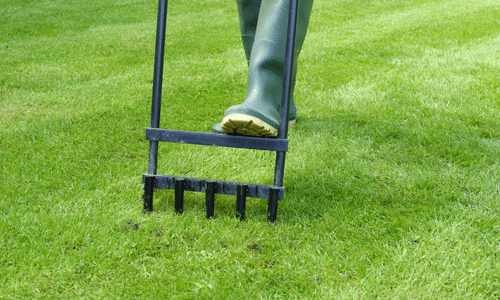Winter is approaching as the evenings become shorter. The best time to work on your lawn is to fix the summer’s damage and prepare it for next spring. You’ll be rewarded with lush, healthy spring grass if you give it a little TLC now. Read our advice here:
Continue mowing!

Keep mowing as long as the weather permits it, and the land continues to exhibit signs of growth. To allow more sunshine to reach the grass’s root system and reduce the length that will turn brown during the winter, lower the blade on your lawnmower during the final few cuts of the year.
Scarify
To get rid of the thatch or “undergrowth,” scarify your lawn. Additionally, it will eliminate the inevitable moss patches that grow on most properties.
The grass may initially seem bad, but it will eventually look much better. Scarification can be carried out using a scarifier, or if you’re feeling spirited, a strenuous raking session will produce equivalent results!
Aerate
Aerating the lawn comes next after scarifying. Similar to scarification, it works best when the soil is damp. Aeration is the process of creating holes in the land’s surface. You can do this by raking a garden fork over the grass, digging a fork into the yard, or using a mechanised aerator.
The holes create a stronger, more cheerful lawn by breaking up compacted soil and making it easier for oxygen, water, and fertiliser to reach the roots of the grass.

Fertilise
You now need to assist your lawn in recovering from the intrusive scarifying and aerating treatments. Add potassium-rich fertiliser to the soil to help the grass recover from the scarifying stress and ward off illness.
Although the growth of the leaves slows, the roots continue to thrive during the autumn, and fertilizer administration will provide them with the necessary nutrients to grow deep and store nutrients for a strong start next spring.

Seed
Filling in divots, holes, and bald places in your grass is also a terrific idea in the autumn. You can fill gaps and level surfaces by brushing in the soil before scattering new grass seeds.
Since some grass dies off every year, it is a good idea to sow new grass seed to the entire current sward, mainly if there is patchy damage throughout the lawn or if you have just finished a very thorough de-mossing and de-thatching. A weed invasion is less likely the thicker the grass base is!
Autumn weather benefits healthy grass establishment if you’re looking to start a new lawn using turf or seed.

Rake leaves up
Finally, while they are still falling from the trees, remove fallen leaves from your yard as soon as possible. Allowing them to accumulate and then become wet from rain and dew will cause them to cling together and form a layer that will suffocate the grass and spread fungus.
If your lawn is too big to hand rake the leaves, this can be solved by routinely mowing it using a lawnmower equipped with a collection bag. That’s it! Your grass will be thick, lush, and green by next spring if you complete three quick tasks throughout the fall.

Our Services
Latest Posts
- Transform Your Outdoor Space: Top Landscape Design Trends for 2024
- How to Choose the Perfect Plants for Your Garden: Expert Tips
- Snow Relocation and Hauling: Strategies for Managing Excess Snow in Your Property
- DIY Snow Relocation and Hauling: Tips for Handling Excess Snow Efficiently
- Snow Salting and Sanding: Essential Techniques for Safe Winter Surfaces

Let us know how we can help with all your residential and commercial lawn and landscaping needs, including overseeding, by calling or sending us a message at RDK LANDSCAPING.





